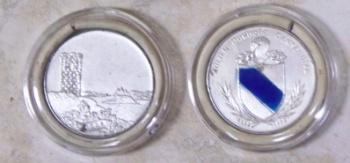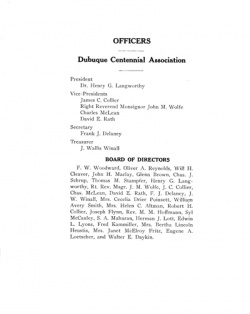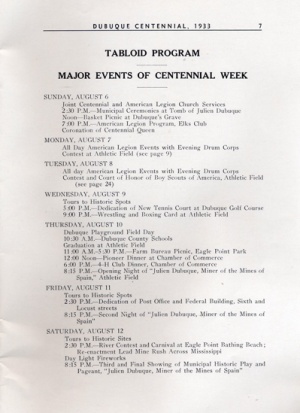Encyclopedia Dubuque
"Encyclopedia Dubuque is the online authority for all things Dubuque, written by the people who know the city best.”
Marshall Cohen—researcher and producer, CNN
Affiliated with the Local History Network of the State Historical Society of Iowa, and the Iowa Museum Association.
JULIEN DUBUQUE CENTENNIAL
JULIEN DUBUQUE CENTENNIAL. The Julien Dubuque Centennial was held from August 6-12, 1933. In the week's long celebration, a play "Julien Dubuque, Miner of the Mines of Spain" was performed three times. The post office and federal building at Sixth and Locust and the new tennis court at Dubuque Golf Course were dedicated. Contests and picnics or dinners were nearly daily occasions.
Concurrent with the centennial was the Indian Tribal Arts Exhibit under the joint sponsorship of the DUBUQUE ART ASSOCIATION and the Centennial Commission. The 615 articles from across the United States displayed included carved bear teeth, silver jewelry, baskets, pottery, masks, toys, antiques and modern color painting. Forty paintings by Indian artists were loaned by collectors and an additional pictures of historic Dubuque by Kate Keith VAN DUZEE.
According to an article in the Telegraph Herald, the five-day celebration was the largest in the history of Dubuque. An estimated 15,000 people attended the army show at MELODY MILL on Sunday afternoon with thousands more unable to reach the grounds due to traffic jams.
Water sports were an important feature of the Centennial. There was a river swim reenacting the rush for LEAD at the time of the opening of the Blackhawk Territory for settlement. A similar reenactment race was held for "pilots" of flatboats, canoes, and "novelty" craft with the exception of anything having a motor or sharp nose. Rafts, barrels and logs were permitted. A prize was awarded in each of the following categories: swimming, flatboats, canoe, and novelty boat. An additional prize was awarded for the most unique method of crossing the river and another for best costume. (1)
Water sports also included a ten-mile marathon in which each person finishing received a medal. Diving contests had age divisions: cadets (under 12), juniors (12-16), and seniors (over 17). There was a male and female category within each division. Judges included Oran H. PAPE. (2)
Crowds estimated at 10,000 visited the lock site to witness the dedication ceremony and 10,000 more gathered at EAGLE POINT PARK to review the parade of river boats and hear the speeches over the loud speaker system connected to the War Department boat "Ellen" where the ceremony took place at the lock chamber.
The largest crowd, however, witnessed the parade opening the celebration on Wednesday. Estimates as high as 50,000 lined the 27 blocks of the parade route.
Other events of the sesquicentennial also attracted enormous crowds. The final performance of the pageant, "Under Five Flags," on Sunday night brought the total attendance for the five evenings to 20,000. The Children's Day Parade on Thursday drew 3,000. Railroad exhibits attracted over 8,000 during the five days and the Agriculture Day festivities on Friday drew another 1,000.
Miss Hazel Skemp, the event queen, christened the lock and dam with a bottle of water containing water from both the Atlantic and Pacific oceans. The water had been brought to Dubuque several years before by Richard BISSELL after an ocean cruise.
---
Source:
1. "Lead Mine Rush is Feature of City Celebration," Telegraph-Herald and Times-Journal, August 2, 1933, p. 11
2. Ibid.








